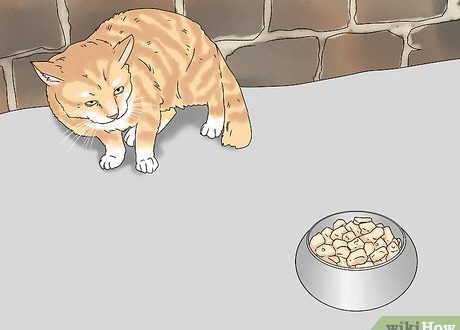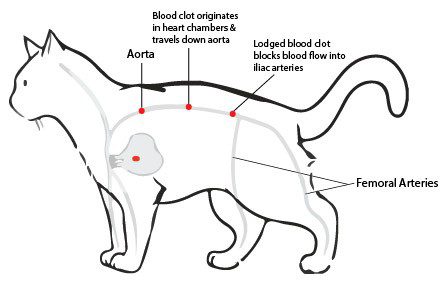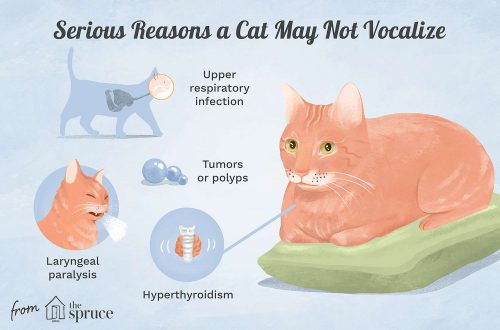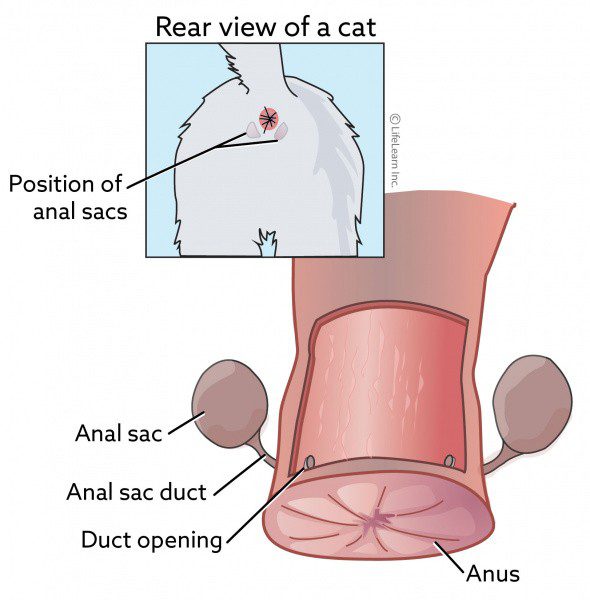
Paraanal glands in a cat: inflammation and treatment
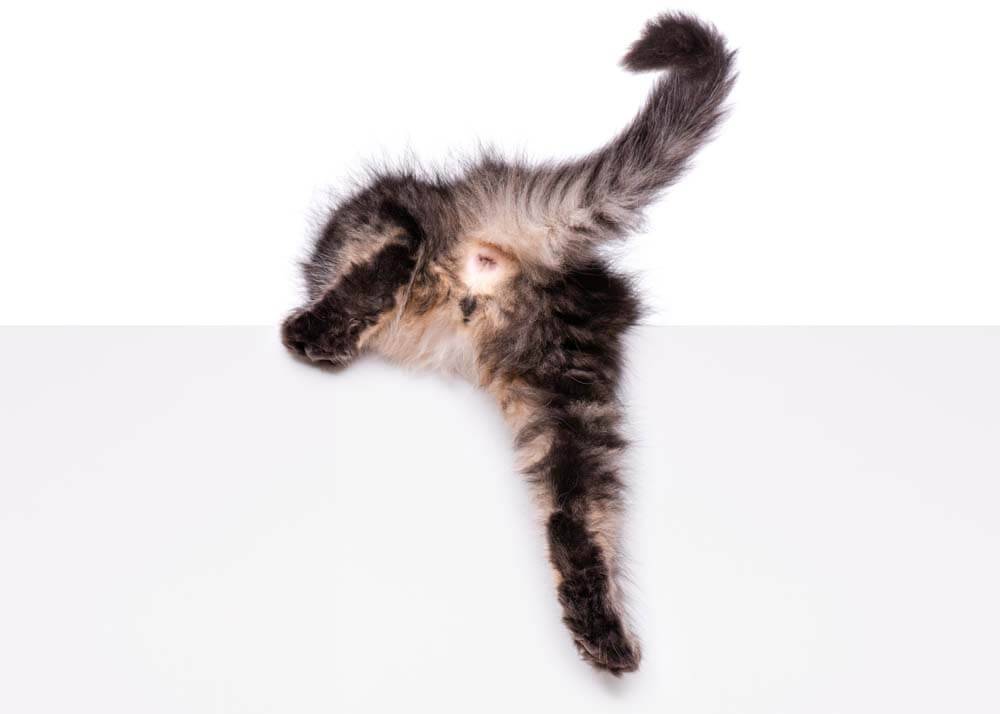
Contents
About the anal glands
The paraanal glands are located under the cat’s tail. Conventionally, their location on the sides of the anus can be represented as the position of the hands at 4 and 8 o’clock on the dial. In shape, they are bags or balls. These are external secretion glands that produce and secrete a thick secret that has a specific odor and is most often brown in color. With inflammation of the paraanal glands in a cat, the color of the contents changes to white, red or almost black. They serve as animals for acquaintance, highlighting individual smell, as well as for marking the territory and attracting the opposite sex. When a pet goes to the litter box for the purpose of defecation (defecation), these sacs are squeezed by the formed feces, the contents are emptied, and the glands are cleansed. They can be released during times of severe stress due to muscle contraction. Similarly, skunks scare off enemies by shooting the contents of the paraanal glands.
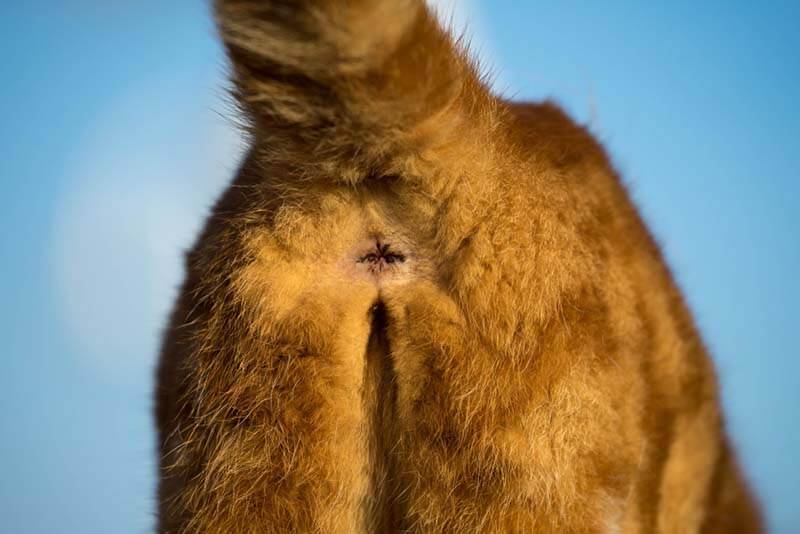
Common Causes of Gland Problems
The most common causes of problems with paraanal glands include:
Lack of exercise (walking for the purpose of rest). Cats with low physical activity are at greater risk of inflammation of the anal glands. They have no need to mark territory, they have a reduced metabolism
Anatomical birth defects
Diseases of the gastrointestinal tract. If a pet has too loose stools for a long time, then the emptying of the glands does not occur as expected. Also, with prolonged constipation, they remain full for a long time.
Neoplasms – tumors under the tail, in the anus – will not allow the glands to be released due to mechanical compression
Injuries can disrupt the patency of the excretory channels and cause difficulty with defecation
Symptoms
Most often, owners find the following symptoms in pets: riding on the priest, intensive licking of the anus, difficulty with defecation. Often they note that the animal’s butt becomes red, it smells unpleasant from under the tail. When the secretion stagnates, its color and consistency change. It can become almost black, and with bacterial contamination (the spread of the infectious agent) – light or have flaky impurities. With severe inflammation of the anal glands in a cat, blood begins to join the brown secret, and the color turns red. With prolonged stagnation, the contents become very thick and resemble plasticine.
Crowded glands increase in size, which makes it easy to feel them on palpation. Sometimes a bump appears under the tail. During a trip to the tray, the cat often experiences pain, meows loudly, takes unnatural poses. Because of the pain and itching, she rides on the priest. This behavior is most often associated in owners with helminthic invasion (penetration).
It happens that the animal begins to actively lick the hair not only in the anus, but also in the back, tail root, sides and hips. Wool in these places becomes rarer, and sometimes falls out completely.
Due to pain and inflammation, the pet becomes lethargic, eats poorly, lies a lot, and lameness may occur.
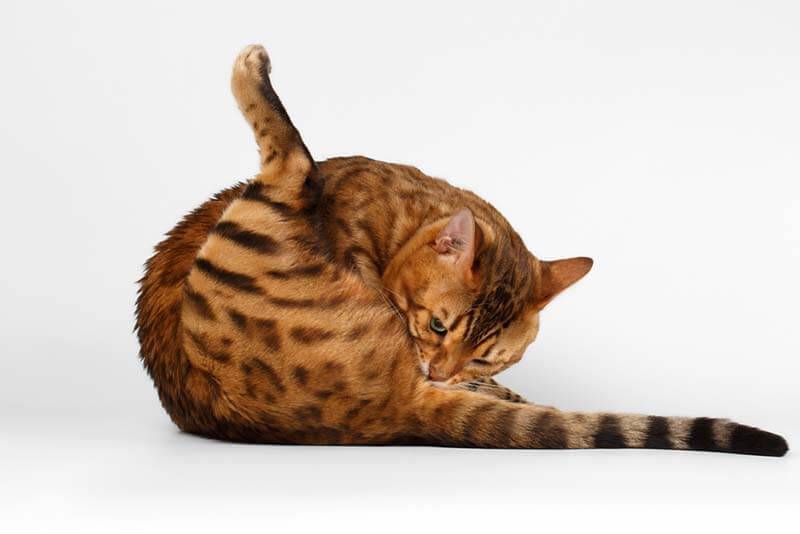
Diagnostics
Inflammation of the paraanal glands in a cat is otherwise called paraanal sinusitis. If the connective tissue around the rectum becomes inflamed, then this is paraproctitis. The diagnosis is made, for the most part, on the basis of anamnesis data (a medical history compiled from the words of the owner), that is, according to characteristic complaints.
A specialist performs diagnostic cleaning of the paraanal glands. According to the volume of contents, its color and consistency, a diagnosis is made. A thick, dark secret indicates a violation of the patency of the channels. White, with flaky impurities – about the presence of an infectious process. If a bulky swelling is found on the side of the anus, at the location of the gland, an abscess is most likely to be diagnosed.
There are no predisposed breeds to this disease, both outbred cats and breeds such as British, Scottish, Persian, Abyssinian, Russian Blue and others can get sick.
Often, patients with already opened abscesses in a cat turn to the clinic, and then the examination often reveals a wound channel with bloody discharge from the anus.
Additional diagnostic methods are used extremely rarely. With signs of the development of systemic inflammation – sepsis – blood tests are usually prescribed. With constantly recurring (returning) problems with the glands, ultrasound or computed tomography is prescribed.
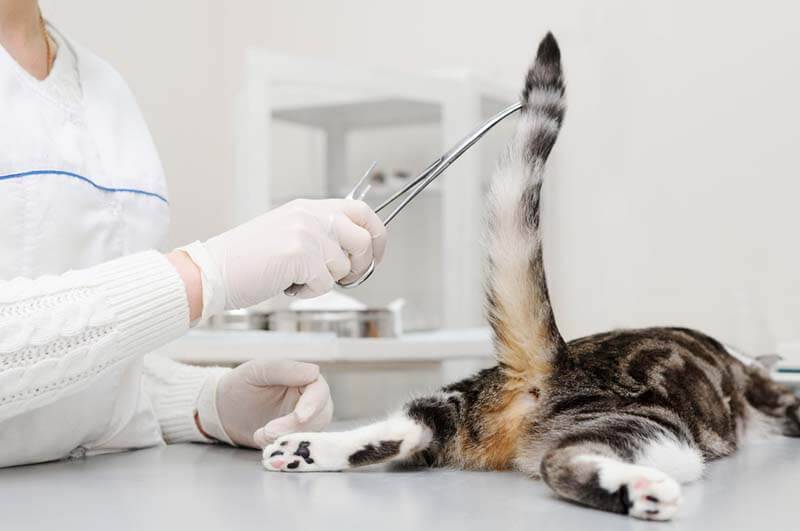
Treatment of paraanal glands in cats
In most cases, treatment consists of cleaning by pressing. The first time the procedure is best to entrust the veterinarian. He will be able to show clearly where the glands are located, how to get to them, and explain what kind of content should alert. If the secret is too thick or has an infectious nature, then washing with antiseptic solutions is additionally used.
If an abscess is detected, it is drained, that is, the cavity is cleaned, washed, and antibacterial ointments are applied. This procedure will need to be carried out daily until complete healing. Sometimes systemic antibiotics are prescribed at risk of developing sepsis, but most often topical treatments are sufficient.
Cleaning the anal glands in cats
In case of blockage of the paraanal glands, mechanical cleaning is primarily used. If the pet began to ride on the priest, intensively lick in the tail area, a characteristic smell appeared, then most likely there is a reason to clean it. When you doubt its necessity, it is better to consult a specialist.
The procedure is to extrude the contents. If you are going to do it at home, you will most likely need an assistant to hold the animal. All these actions are not very pleasant for cats, although not very painful.
In the absence of complaints, the paraanal glands do not need preventive cleaning.
The procedure for cleaning is as follows:
Wear gloves and prepare paper napkins
An assistant holds the pet lying on its side or in a standing position
With one hand, lift the tail up, and with the other, feel for the glands.
They are captured by fingers (thumb and forefinger) from both sides, and after a gradual increase in the force of compression, a thick liquid with a characteristic odor begins to stand out from the anus. It is better to immediately clean it with napkins to avoid getting a secret on clothes and furniture.
If the bags under the fingers are empty, then the cleaning was carried out correctly, and all the contents came out. When they are still full, the cat is in great pain, scratches and runs away, then the best option is to go to a veterinary clinic.
Washing
Flushing is used infrequently, only when indicated. To do this, a soft catheter is inserted into each channel in turn, through which an antiseptic solution is supplied. After the solution is pumped back or squeezed out. So a secret that is too thick is made more liquid so that it becomes possible to empty the glands. Washing allows for antibacterial treatment of the infected cavity.
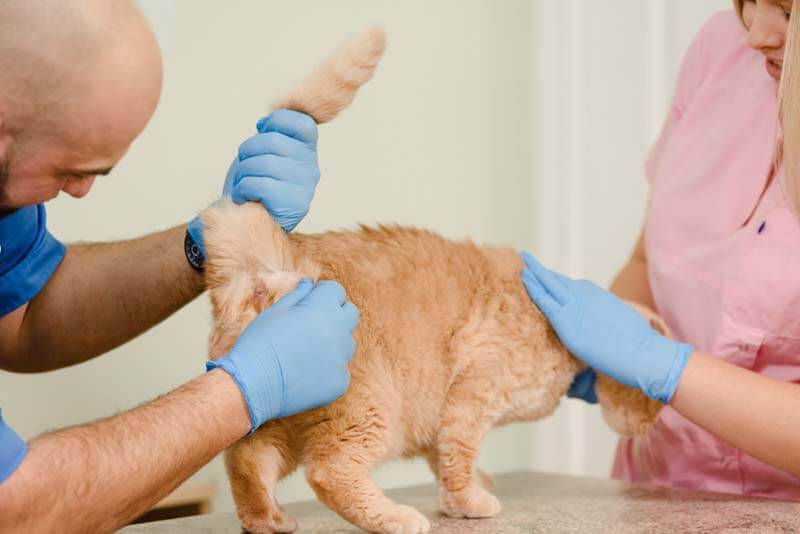
Removal of paraanal glands in a cat
The operation to remove the glands is quite rare. Indications are frequent relapses of blockage or infection, congenital defects in the structure and excretory ducts, neoplasms. In general, the absence of glands does not interfere with the full life of the animal. Regular inflammation, on the contrary, causes constant pain and greatly reduces the quality of life. Therefore, if there are good reasons, this option must be considered.
Possible complications
If your pet has a blockage, you need to visit the clinic to resolve the problem as soon as possible. Lack of treatment in most cases will lead to abscess formation, that is, to the appearance of a cavity infected with bacteria. An abscess of the paraanal gland is an extremely painful condition for a cat. Over time, it can open on its own, and a large wound will appear, which will also continue to become infected. Without treatment, inflammation is likely to spread throughout the body, sepsis will occur, and the animal will die.
Features in kittens
Blockage and inflammation of the paraanal glands in a kitten is extremely rare. It is most likely that in this case there is a congenital anatomical defect, for example, the absence of excretory ducts. Most likely, the problem will be solved surgically.
Prevention
The basis of prevention is high-quality exercise (active, outdoor games) and proper nutrition. In the event of any violations of the gastrointestinal tract, they must be addressed as soon as possible. It is recommended to keep a close eye on active cats to avoid injury. Unfortunately, it is difficult to prevent congenital anatomical defects, neoplasms.
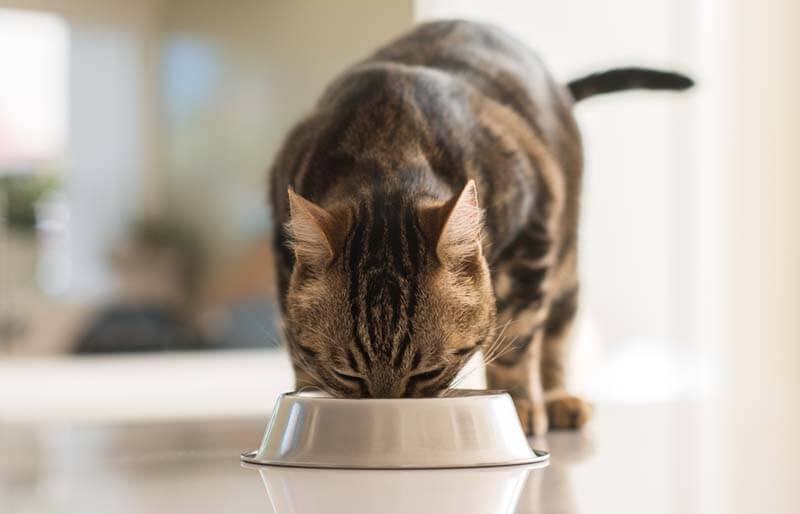
Home
Blockage and inflammation of the anal glands in cats is quite common in practice. Usually, this is a disease of middle-aged animals, it has no sexual predisposition
The main symptoms include the following: riding on the priest, licking the hair in the anus, pain during bowel movements
Treatment primarily consists of flushing the glands, but flushing, systemic antibiotic therapy may also be recommended.
With early detection of inflammation, the prognosis for recovery is most often good, relapses are extremely rare.
Answers to frequently asked questions



